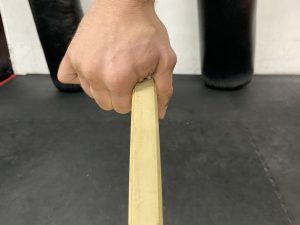Grip strength was discussed in part 11, and if there are deficiencies here then they should be addressed. The power grip can be trained with a simple gripper, and if an adjustable gripper is available, this can allow for a more incremental progression of load. Using a thicker grip, such as a towel, or a fat gripz handle, while performing traditional resistance training exercises can also be effective.
The plate holds that were described in the assessment section may also be used as exercises to train the pinch and key grip. The gripping exercises can be performed with a range of different hold durations.
To balance out the finger flexion work that we get from the gripping exercises, it is also useful to include some finger extensor work, and this can be done with the use of a theraband.
As the wrist in striking sports functions primarily for stability, i.e. resisting motion while movement occurs at the elbow, it makes sense to train it in this way. Biceps curls are a useful way of training isometric wrist contraction while moving at the elbow. These should be performed in a variety of different grips (neutral, supinated, pronated), and the intensity of the isometric contraction may be increased by performing them as a supramaximal eccentric.
Rotation is an important element, particularly with TFCC injuries, and a great way of training mobility, strength and control together is with a bar-loaded supination/pronation exercise. This can be done with a hammer, or weighted bar. The focus should be on maintaining a neutral wrist position in all planes, while rotating through the elbow.
In the latter stages of rehab, programming should include more dynamic exercises, and drills involving some form of unbalanced surface.

